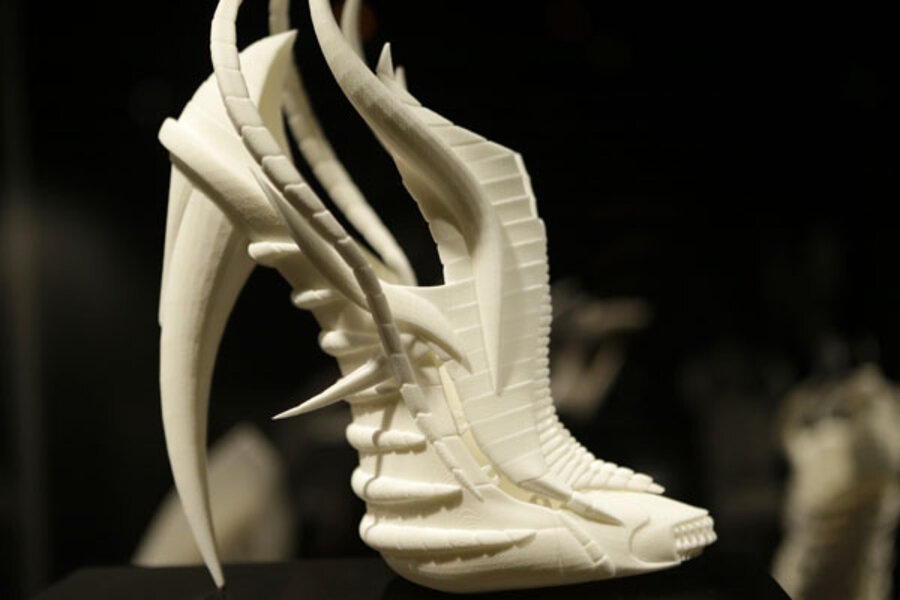3-D printers bring new edge to fashion
Loading...
British designer Janina Alleyne crafts shoes that look as though they're straight out of science fiction – and were created in a way that suits the style.
Ms. Alleyne's shoes come from 3-D printers. She designs her six-inch stilettos on a computer, building digital models of the carapace-inspired toecaps and tusklike heels. Once she completes a design, Alleyne sends the digital schematics to a studio where 3-D printers construct the shoes layer by layer out of white nylon.
Alleyne says that her shoes – elegant yet alien – illustrate the freedom that 3-D printers offer fashion designers. Over the past two years, these machines have printed out everything from personalized bracelets to print-and-wear bikinis. And as designers experiment, they're creating new clothes and new business models beyond the reach of many people who work with traditional materials.
"There are only so many shapes you can produce with leather or rubber soles," says Alleyne, whose 3-D-printed shoes were on exhibit at the Fashion Institute of Technology in New York. "Using 3-D printers allows you to design complex textures and silhouettes that normally would be next to impossible to create in footwear. You can design whatever intricate structures you can imagine and think about the logistics later." (For the record, Alleyne says her wild shoes are quite wearable and "are as comfortable as you'd expect for six-inch stilettos.")
As 3-D printers have improved since the 1980s, they've moved from prototyping tools to machines that can create an entire outfit. In 2011, designers Jenna Fizel and Mary Huang unveiled what they say is the first fully 3-D-printed article of clothing. From a distance, their bikini looks like a simple white swimsuit. But up close, you can see that the material is actually small dots of nylon held together by intricate strings. This mesh design came out of the printer fully formed. Just hook the bikini cups to the two straps and it's ready to wear.
While some 3-D printers squirt out melted plastic to build up objects dollop by dollop, these bikinis were made using a different technique. The machine lays down a thin layer of nylon powder. A laser zaps the powder in particular spots, making those particles just sticky enough to fuse to their neighbors. The printer sprinkles down and zaps thousands of new layers of powder. The fused particles cool and become the final product, while the rest of the powder provides support, allowing for arches and other features that would sag or warp without something holding them in place.
"Once it's done, you excavate it like a dinosaur bone," blowing away the excess powder to reveal the bikini, says Ms. Fizel. This style of 3-D printing can create objects out of plastic, metal, ceramic, or glass, but nylon works best for clothing, she says. Nylon is sturdy, won't degrade over time, and is easy to clean (although Fizel recommends that customers use a dishwasher instead of a washing machine).
Fizel and Ms. Huang sell the bikinis online via their label, Continuum Fashion. Customers can order from one of eight predesigned sizes for $250 to $300, or pay more for Continuum to design a swimsuit that matches their body shape.
The design studio Nervous System in Somerville, Mass., offers a similar deal. You can shop from its online catalog of organic-inspired bracelets and rings, or use its software to create your own printable jewelry. Nervous System has developed several 3-D design programs that run on a Web browser. Select your style, tinker with the settings, choose the size and material, and then click to order. Nervous System sends your personalized schematic to a 3-D printer and mails out the jewelry once it's ready. Company cofounder Jessica Rosenkrantz says that she gets a new order about once a day – everything from nylon necklaces to one-of-a-kind printed platinum wedding rings.
For more on how technology intersects daily life, follow Chris on Twitter @venturenaut.
[Editor's note: This is an updated version of an article that appeared in the February 25 issue of the Monitor weekly magazine.]





